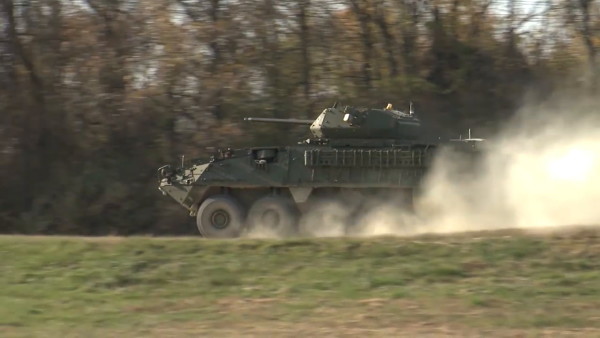

After rolling out a batch of Stryker armored infantry fighting vehicles upgunned with 30mm autocannons to the 2nd Cavalry Regiment in Europe, the Army is eyeing the unmanned turrets for several other ground combat vehicles.
Army Contracting Command on Mar. 6 released a new request for information regarding industry’s capacity to produce the XM813 Remote Weapon System equipped with both the 30mm autocannon and 7.62mm machine gun “compatible with a medium sized combat vehicle platform.’
Those vehicles include the Army’s current M113 armored personnel carrier and the Armored Multi-Purpose Vehicle intended to replace it, suggesting that the Army plans on proliferating the 30mm system across at least some part of its ground combat vehicle fleet.

A Stryker Infantry Carrier Vehicle-Dragoon fires 30 mm rounds during a live-fire demonstration at Aberdeen Proving Ground, Md., Aug. 16, 2017(U.S. Army/Sean Kimmons)
The RFI comes just weeks after the Army awarded a $575 million contract to BAE Systems for the initial production run of the larger and more survivable AMPV, with plans to pick up around 2,897 of the new vehicles to replace the Vietnam-era M113 variants currently in use by frontline combat brigades.
Its worth noting that back in January 2018, BAE Systems had pitched the Army on outfitting its updated M2A5 Bradley Infantry Fighting Vehicle model with the 30mm XM813 weapons platform, which is manufactured by Orbital ATK. That replacement was canceled last February over survivability concerns.
According to Army Times, the upgunned Stryker-Dragoons fielded to 2nd Cav soldeirs in Europe offered a significant range and firepower boost over the standard twin M2 .50 cal machine guns, including munitions options with airburst effects.
But the extra lethality has its drawbacks. During testing with 2nd Cav solders last year, “adversaries demonstrated the ability to degrade select capabilities of the [Dragoon] when operating in contested cyber environment,” according to the Pentagon’s operational testing and evaluation report released in January.
Given that the “exploited vulnerabilities predate the integration of the lethality upgrades,” it’s unclear how proliferating the XM813 Remote Weapon System across Army ground combat vehicles might have on their own unique cyber vulnerabilities.
